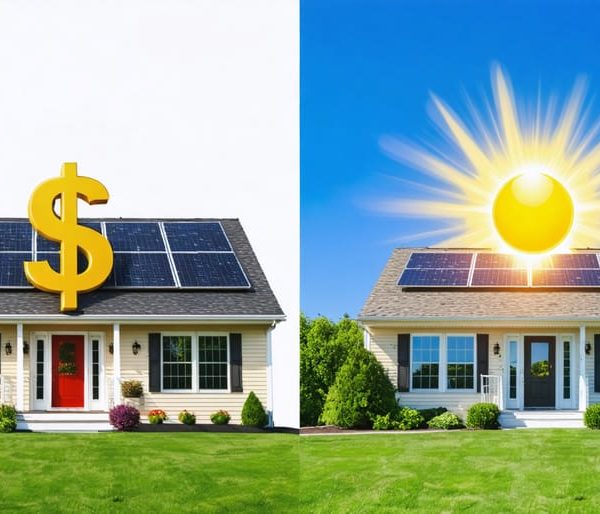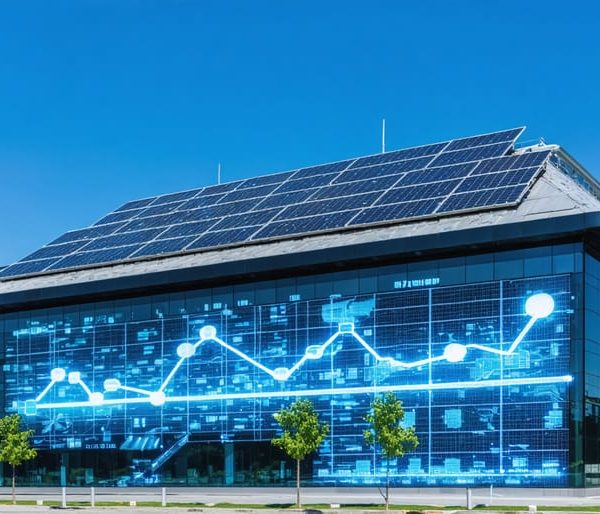Solar Panels Pay You Back: The Financial Wins Most Homeowners Miss
Transform your monthly electricity bills into a smart investment with solar energy’s compelling financial rewards. Today’s solar installations deliver an average return on investment of 20% or higher, outperforming many traditional investment vehicles while providing decades of reliable energy savings.
Homeowners who switch to solar typically reduce their electricity costs by 50-90%, translating to $10,000-$30,000 in savings over the system’s lifetime. Factor in federal tax credits covering 30% of installation costs, state-specific incentives, and local utility rebates, and the financial case becomes even more attractive. Property values increase an average of 4.1% with solar installations, adding another layer of financial benefit beyond direct energy savings.
Modern solar technology has dramatically reduced installation costs while improving efficiency, making 2024 an ideal time to invest in residential solar. With flexible financing options, including zero-down solar loans and power purchase agreements, homeowners can start saving immediately without significant upfront costs. The combination of reduced energy expenses, tax incentives, increased property value, and protection against rising utility rates makes solar energy not just an environmental choice, but a smart financial decision.

Immediate Cost Savings on Energy Bills
Calculate Your Monthly Energy Savings
To determine your potential monthly energy savings with solar panels, start by gathering your past 12 months of electricity bills. Calculate your average monthly electricity usage in kilowatt-hours (kWh) and multiply it by your current electricity rate. This gives you your baseline monthly energy cost.
Next, estimate your solar energy production potential using these factors:
– Your roof’s sun exposure and direction
– Average sunny days in your location
– Planned solar panel system size
– Local weather patterns
A typical 6kW residential solar system can produce between 720-900 kWh per month in optimal conditions. Multiply your expected solar production by your current electricity rate to see your potential savings. Remember that production varies by season, with higher output during summer months.
To get a complete financial picture, factor in:
– Initial installation costs
– Available tax incentives and rebates
– Maintenance expenses
– Potential energy price increases
Use our online calculator to calculate your solar ROI and see your personalized savings estimate based on these factors.
Peak Hour Benefits
Solar panels offer a strategic advantage during peak electricity hours when utility rates are at their highest. Typically occurring between 4 PM and 9 PM, these peak hours can cost homeowners up to double the standard electricity rate. By generating your own solar power during daylight hours, you effectively shield yourself from these expensive rate periods.
Many solar systems generate excess energy during sunny afternoons, which coincides with the beginning of peak rate times. Through net metering programs, this surplus energy can be fed back into the grid, earning you credits that offset your evening electricity consumption. This means you’re essentially banking solar power when rates are highest, maximizing your financial returns.
For businesses, the benefits are even more substantial. Commercial peak rates can be significantly higher than residential rates, and solar panels can dramatically reduce these costly daytime energy expenses. By generating power during business hours when electricity demand is highest, commercial solar installations often pay for themselves faster than residential systems.
Smart energy management systems can further optimize these benefits by storing excess solar energy in batteries for use during peak hours, ensuring you get the most value from your solar investment.
Government Incentives That Make Solar More Affordable
Federal Tax Credits
The federal government offers substantial tax incentives to encourage solar adoption, making it more affordable than ever to switch to clean energy. Through the Inflation Reduction Act of 2022, homeowners can claim up to 30% of their total solar installation costs as a tax credit through 2032. This significant benefit applies to both residential and commercial installations, helping offset the initial investment in solar rebates and incentives.
To claim this credit, you’ll need to file IRS Form 5695 with your annual tax return. The credit covers not only the solar panels but also installation costs, permit fees, and necessary equipment like inverters and mounting hardware. If your tax liability is less than the credit amount in the installation year, you can carry over the remaining credit to subsequent tax years.
For a typical residential installation costing $20,000, this means you could receive up to $6,000 back in tax credits. Remember that this federal incentive can be combined with state and local programs, multiplying your savings potential. It’s important to consult with a tax professional to ensure you maximize these benefits and properly document your solar investment.

State and Local Programs
Beyond federal incentives, many states and local governments offer additional financial perks for solar adoption. These state solar incentives can significantly reduce your installation costs and improve your return on investment.
Programs vary widely by location, but common offerings include tax credits, rebates, and performance-based incentives. For example, some states offer property tax exemptions for the added home value from solar installations, while others provide cash rebates based on system size or energy production.
Many utility companies also participate in solar incentive programs, offering net metering arrangements that credit you for excess energy your system produces. Some even provide upfront rebates or performance-based payments.
To maximize your benefits, research local programs early in your solar planning process. Contact your utility provider and local government offices to understand available incentives. Many programs have specific application deadlines and requirements, so timing is crucial. Remember that these incentives often change yearly, and some have limited funding, so acting promptly when you find a suitable program is essential.
Home Value Appreciation

Real Estate Market Advantages
Installing solar panels isn’t just about reducing energy bills – it’s also a smart real estate investment. According to recent studies by Zillow, homes with solar installations sell for an average of 4.1% more than comparable properties without solar systems. For a median-valued home, this translates to an additional $9,274 in resale value.
The National Renewable Energy Laboratory (NREL) reports that each additional $1 in energy bill savings from solar adds $20 to your home’s total value. What’s more, homes with solar installations typically sell 20% faster than those without, making them particularly attractive in competitive real estate markets.
California’s Lawrence Berkeley National Laboratory found that homebuyers consistently pay a premium for homes equipped with solar panels, with premiums ranging from $4 to $6 per watt of installed solar capacity. For a typical 6-kilowatt system, this could mean an added value of $24,000 to $36,000.
Real estate agents increasingly highlight solar installations as a prime selling feature, particularly appealing to environmentally conscious buyers who prioritize energy efficiency and sustainability in their home purchases.
ROI Timeline
The typical solar panel payback period ranges from 5 to 10 years, depending on your location, energy consumption, and available incentives. During the first year, homeowners often see immediate savings of 30-50% on their monthly electricity bills. These savings continue to grow as utility rates increase over time, while your solar energy costs remain fixed.
Most solar panels come with 25-30 year warranties, meaning you’ll enjoy roughly 15-20 years of pure savings after reaching your break-even point. Property value typically increases by 4-6% with solar installation, providing immediate equity gains. For a $300,000 home, this could mean an additional $12,000-$18,000 in value.
The ROI timeline accelerates when you factor in federal tax credits, state incentives, and potential SREC (Solar Renewable Energy Certificate) income. Many homeowners find their systems paying for themselves faster than expected, especially in states with strong solar incentive programs and high electricity rates.
Net Metering Benefits
Net metering is one of the most attractive financial perks of going solar, acting like a savings account for your excess energy production. When your solar panels generate more electricity than you’re using, that surplus power flows back into the grid, and your utility company credits your account for this contribution.
Think of it as running your electric meter backward. During sunny days, when your panels are working at peak efficiency, you’re essentially banking energy credits. These credits come in handy during nighttime or cloudy days when your system isn’t producing as much power. The best part? You’re getting retail rate credits for the excess electricity you generate, which can significantly reduce or even eliminate your monthly electric bills.
For example, if your solar panels produce 50 kilowatt-hours (kWh) of excess energy in a day, and your utility company’s rate is $0.12 per kWh, you’ll earn $6 in credits for that day alone. Over a month, these savings can add up to substantial amounts, especially during summer months when solar production is at its highest.
Many homeowners find that net metering allows them to offset their annual electricity costs by 90% or more. This benefit is particularly valuable in states with higher electricity rates, where the credits earned through net metering are worth more. However, it’s important to note that net metering policies vary by state and utility company, so checking your local regulations is essential when calculating potential savings.
Remember that these credits typically expire after a set period, usually 12 months, so sizing your system correctly for your needs is crucial to maximize the benefits of net metering.
Long-Term Energy Independence
Installing solar panels is like buying your own power plant – it’s a strategic move toward energy independence that pays dividends for decades. While the initial investment might seem substantial, solar energy systems effectively lock in your electricity rates for 25-30 years, protecting you from the ever-rising costs of grid electricity.
Consider this: utility rates have historically increased by about 2-3% annually, and this trend is likely to continue. By generating your own electricity, you’re essentially pre-paying for decades of power at a fixed rate, creating a hedge against future price hikes. This predictability in energy costs is particularly valuable for both homeowners and businesses trying to manage long-term expenses.
Energy independence also means reduced vulnerability to grid-related issues. During power outages, homes with solar-plus-storage systems can maintain essential operations, providing both security and convenience. This self-sufficiency becomes increasingly valuable as extreme weather events and grid stability concerns grow.
The financial benefits extend beyond direct savings. Properties with solar installations typically command higher resale values, with studies showing an average increase of 4.1% compared to similar non-solar homes. For commercial properties, energy independence can be a significant selling point for potential tenants, potentially commanding premium rental rates.
Moreover, as electricity demand continues to rise with the increasing adoption of electric vehicles and smart home technologies, having your own power source becomes even more financially advantageous. You’re not just saving money today – you’re investing in a future where energy costs are increasingly under your control.
The financial advantages of solar energy present a compelling case for making the switch to renewable power. From substantial utility bill savings and increased property values to generous tax incentives and attractive financing options, solar installations offer multiple paths to financial benefit. Homeowners can expect to see their electricity costs drop by 50-90% while protecting themselves against rising energy prices. Additionally, many solar systems pay for themselves within 5-8 years, after which they continue generating free electricity for decades.
The time to act is now. With current federal and state incentives at their peak, combined with historically competitive installation costs, conditions are ideal for maximizing your return on investment. Whether you’re a homeowner looking to reduce monthly expenses or a business owner aiming to lower operational costs, solar energy offers a proven path to long-term savings.
Take the first step toward energy independence and financial benefits by requesting a solar consultation today. Join the millions of Americans already benefiting from clean, renewable solar power while securing their financial future.











